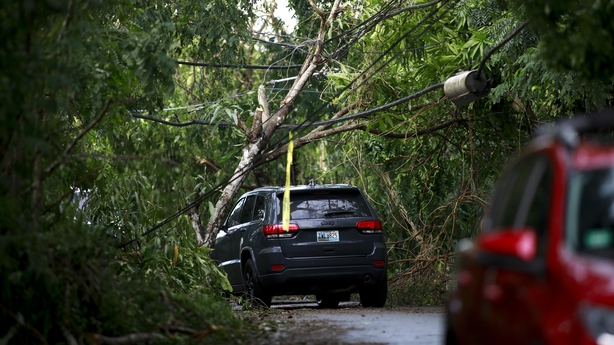Hurricane Fiona is threatening the Atlantic island of Bermuda, passing west of the British territory on its northward trek towards Nova Scotia while packing the potential to become one of the most severe storms in Canada's history.
Fiona already battered a series of Caribbean islands earlier in the week, killing at least eight people and knocking out power for virtually all of Puerto Rico's 3.3 million people during a sweltering heatwave.
Bermudians boarded up windows and stocked up on groceries and flashlight batteries while bracing for the storm, which was expected to make its closest approach to Bermuda in the early morning hours.
The centre of Fiona will thread a path up the Atlantic between Bermuda and the east coast of the United States, but the storm's outer bands will still lash the territory with powerful winds, pounding rain and storm surge.

Across the island, people cleared loose debris from yards and readied to close storm shutters.
Many homes are built with small shuttered windows, slate roofs and limestone blocks to withstand frequent hurricanes.
"I'm taking every precaution to stay safe," said Dean Williams, a resident of the capital city of Hamilton.
"Preparation is the key because at its highest intensity we can do nothing but wait it out."
As of 1am Irish time, Fiona had maximum sustained winds of 215km/hr and was about 455km west-southwest of Bermuda and moving north-northeast at 31km/hr, the National Hurricane Center in Miami said.
That made it a Category 4 hurricane on the five-step Saffir-Simpson scale, meaning it was capable of producing catastrophic damage.
It was also 1,610km south-southeast of Halifax, the capital of the Canadian province of Nova Scotia.
Fiona is shaping up to be the most powerful storm to reach Canada since Dorian made landfall to the west of Halifax in September 2019, the government's Environment Canada website said.
This storm is expected to bring hurricane-force winds and torrential rain to the Atlantic provinces and eastern Quebec beginning this afternoon and extending through Saturday.
Much of Atlantic Canada has been upgraded to HURRICANE WARNINGS & TROPICAL STORM WARNINGS. This means hurricane and/or tropical storm conditions are expected within 24 hours. #atlstorm #TWNStormCentre #nlwx #Fiona #HurricaneFiona pic.twitter.com/PxB91UpNGP
— Dayna Vettese 🍂 (@daynavettese) September 23, 2022
It appears likely to track through the eastern part of Nova Scotia before barreling north into Newfoundland and Labrador by Sunday.
A broad swath of Atlantic Canada, including parts of Prince Edward Island, New Brunswick and eastern Quebec, will feel the storm's clout.
Like Dorian, Fiona could ease to a post-tropical storm, but Dorian still carried Category 2 intensity, with sustained winds of 155km/hr.
It toppled century-old trees and triggered an extensive power outage.
Fiona could also dump more rain. Forecasters say areas close to its path could get up to 200mm of rain, while winds could damage buildings and cause utility outages, with storm surges swamping the coastlines.
The hurricane already displayed its devastating strength in Puerto Rico and other islands of the Caribbean, killing at least four people in Puerto Rico, the US Federal Emergency Management Agency said.
US President Joe Biden, at a briefing in New York, said the federal government would fund debris removal, power and water restoration and shelter and food for the next month.
An estimated 1 million homes and businesses remained without power in the US territory yesterday after Fiona hit on Sunday, while people sweltered in the heat and humidity.

